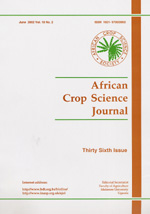
|
African Crop Science Journal
African Crop Science Society
ISSN: 1021-9730
EISSN: 1021-9730
Vol. 5, No. 1, 1997, pp. 47-53
|
 Bioline Code: cs97007
Bioline Code: cs97007
Full paper language: English
Document type: Research Article
Document available free of charge
|
|
|
African Crop Science Journal, Vol. 5, No. 1, 1997, pp. 47-53
| en |
Feasibility of chemical control of the African bollworm on sunflower in South Africa
Du Plessis, H.
Abstract
The efficacy of methomyl and fenvalerate as a tank mixture for the control
of African bollworm (Helicoverpa armigera Hubner) was compared by means of
aerial application from two directions in relation to row direction and two
plant reproductive stages (budding R-3, and during flowering and
pollination, R-5) of sunflower (Helianthus annuus L.). Chemical control was
effective during both reproductive stages, reductions in pest numbers
ranged from 55.3% during R-3, to 86.5% during R-5, irrespective of the
direction of application. Cost of control constituted 14% of the net profit
margin. To determine the effect on yield and the ability of sunflower to
compensate, insect damage was simulated on florets before pollination as
well as on young achenes in the milky stage. A reduction in yield, although
not significantly different from the undamaged control heads, was observed
at damage level greater than 20%. Due to the cost of aerial insecticide
application and the ability of sunflower to compensate for losses, chemical
control of H. armigera should not be applied at first signs of eggs or
larvae. Based on observations in this study, it is proposed that
insecticide application be done when at least 20% damage per head occurs.
Keywords
Helicoverpa armigera, Lepidoptera, compensation, Helianthus annuus
|
| |
| fr |
Du Plessis, H.
Résumé
L'efficacite de methomyl et de fenvalerate pour controler le ver du grain
Africain (Helicoverpa armigera Hubner) etait comparee par une application
aerienne en deux directions en relation avec la direction en rangees, et a
deux phases reproductives, (phase bouton, R-3 et pendant la floraison, et
phase pollinisation, R-5) du tournesol (Helianthus annuus L.). Le controle
chimique etait efficace pendant les deux phases reproductives et la
reduction du nombre d'insectes variait entre 55.3% en R-3, a 86.5% en
R-5, independamment de la direction d'application. Les couts du controle
constituaient 14% de la marge beneficiaire nette. Pour determiner l'effet
sur la recolte et la possibilite de compensation du tournesol, l'attaque
des insectes etait simulee sur des fleurons avant pollinisation et aussi
sur les akenes a la phase laiteuse. Une reduction de la recolte, mais pas
significativement differente des temoins, etait observee a un niveau
d'attaque de plus que 20%. Comme les insecticides sont chers et le
tournesol possede la capacite de compenser des pertes, un controle chimique
n'est pas recommande des qu'on observe des oeufs ou des larves. Se basant
sur les observations de cette etude, on propose une application
d'insecticide quand 20% d'attaque par tete de fleur apparait.
Mots Clés
le ver du grain Africain, controle chimique, compensation, Helianthus annuus
|
| |
© Copyright 1997 - African Crop Science Society
|
|
